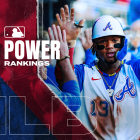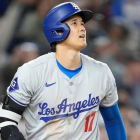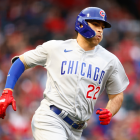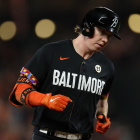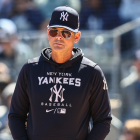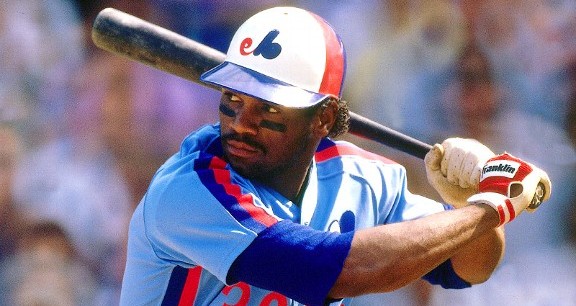
For the next several days, we at Eye On Baseball will be breaking down the cases of each candidate on the BBWAA Hall of Fame ballot for 2015. We'll present the pros and cons of each player as they relate to existing Hall of Fame standards and then wager a guess as to whether or not the candidate in question makes it in this time around by earning the necessary 75 percent of votes. Up now is Tim Raines ...
After a career that spanned parts of 23 seasons with six different teams, Raines retired following the 2002 season as arguably the second best leadoff hitter in baseball history. Unfortunately for him, his career was often overlooked those 23 seasons because it overlapped with the career of the undisputed best leadoff hitter in baseball history (Rickey Henderson).
Raines, who was a fifth round pick in the 1977 draft, made it to MLB with the Expos in 1979 but didn't stick for good until the 1981 season, when he led baseball with 71 steals despite playing only 88 games. (The work stoppage cut the season down to 108 games.) He finished second to Fernando Valenzuela in the NL Rookie of the Year voting and was an All-Star for the first time during that 1981 season.
From 1981-84, Raines led the NL in stolen bases each season, averaging 79 steals per year. He also stole 70 bases on the nose in both 1985 and 1986. From 1981-92, Raines stole 723 bases in 850 attempts, an incredible 85.1 percent success rate. He averaged 60 steals per season from 1981-92 -- his lowest stolen base total during that stretch was 41 in 1985, one of only three times he dipped under 50 -- and his 583 steals during the 1980s ranked second to Henderson (838).
During his offensive peak from 1981-87, Raines hit .310/.396/.448 (135 OPS+) with an average of 172 hits, 31 doubles, nine triples, nine home runs, 72 stolen bases, 79 walks and 61 strikeouts per season. He was an All-Star all seven years and received MVP votes in six of the seven seasons as well, topping out at fifth place in the voting in 1983. Raines racked up 38.4 WAR from 1981-87, the fifth most in MLB behind four Hall of Famers: Henderson (47.1), Mike Schmidt (46.1), Wade Boggs (43.3) and Gary Carter (83.4).
The Expos traded Raines to the White Sox following the 1990 season and he played there until 1995, when he was traded to the Yankees. Raines was done as an everyday player in 1996, his age 36 season, but he still hung around for a few years as a valuable platoon player, hitting .299/.395/.429 (115 OPS+) during three seasons in New York before moving on to the Athletics, Marlins, Orioles and eventually back to the Expos.
Raines retired as a career .294/.385/.425 (123 OPS+) hitter with 2,605 hits, 430 doubles, 113 triples, 170 homers, 980 RBI, 808 steals, 1,330 walks, 966 strikeouts and 69.1 WAR. He ranks fifth all-time in steals, 37th all-time in walks, 47th all-time in times on base (3,977), 53rd all-time in runs scored (1,571), 71st all-time in WAR, and 77th all-time in hits. Raines is just ahead of another non-power hitting corner outfielder from the same era on the all-time WAR list -- Hall of Famer Tony Gwynn (68.8 WAR).
The case against Raines is that aside from his incredible stolen base total, he didn't reach any of the other traditional Hall of Fame milestones. He's well short of 3,000 hits, isn't a career .300 hitter, didn't hit for much power, and didn't win any major awards. (And, of course, he's also guilty of not being Rickey Henderson.) Raines battled substance abuse early in his career -- he admitted to using cocaine, including between innings at times, and said he learned how to slide head-first because he carried drugs in his back pocket during games -- and later on was diagnosed with lupus, which caused him to miss time and hurt his counting stats in his late 30s.
For a more analytical approach to Raines' Hall of Fames candidacy, let's once again turn to Jay Jaffe's JAWS system. According to JAWS, Raines meets and slightly exceeds the established Hall of Fame standards for left fielders, both in terms of peak value and overall career value. In fact, he rates eighth all-time in JAWS by a left fielder, and five of the seven ahead of him are in Cooperstown. The other two are Barry Bonds and the ineligible Pete Rose.
This is Raines' eighth year on the Hall of Fame ballot and his support has been generally trending upward. Here are his voting percentages:
2008: 24.3 percent
2009: 22.6 percent
2010: 30.4 percent
2011: 37.5 percent
2012: 48.7 percent
2013: 52.2 percent
2014: 46.1 percent
Because the ballot was so stuffed last year -- it continues to be stuffed this year -- Raines lost some votes simply because voters are only able to vote for a maximum of 10 players. He was squeezed off the ballot. The good news for Raines is that his support has more or less doubled during his seven years on the ballot.
Raines is essentially a borderline Hall of Famer whose case for induction has been enhanced through sabermetrics, which have put his pure on-base ability and base-running value into better context. He was a historically great base-stealer and his peak in the early-to-mid 1980s was incredible by leadoff hitter standards. He also has the career longevity voters like to see.
I don't expect Raines to get into the Hall of Fame this year, mostly because the ballot is stacked and he seems to be an easy candidate to leave off, but I do believe his support will continue to increase.













